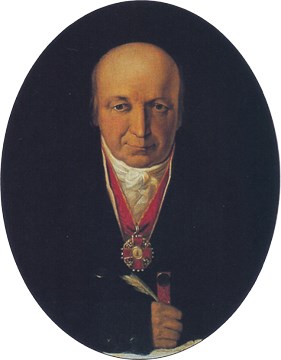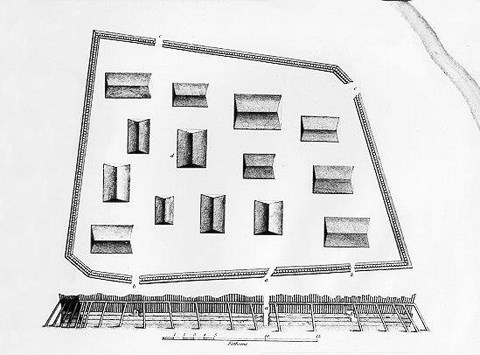
After the Battle of Old Sitka in 1802, the Tlingit clan house leaders debated their next move. Some advised caution and diplomacy. Others advocated rallying clans from across southeast Alaska to go on the offensive and attack Russian settlements in Yakutat and Prince William Sound. According to Tlingit oral tradition, the respected tribal Shaman Stoonook foresaw the return of Alexander Baranov in a vision. Stoonook urged the clan leaders to unite and build a new fort in a defensible location. In a move that reflected the gravity of the situation, the Sitka clans both rallied around their own leaders and decided to appoint a single war chief. They selected K'alyáan, the Point House aristocrat who had proven his bravery in the Battle of 1802. K'alyáan heeded Stoonook's prophetic vision and rallied the clans to construct a fort, subsequently named Shis'gi Noow, at the mouth of the Indian River. Shis'gi Noow means Sapling Fort, Second Growth Fort, or Green Wood Fort in English. They constructed the fort adjacent to very shallow tidelands to prevent the Russians from moving their ship-based artillery near the fort's walls, effectively neutralizing its military advantage.The Sitka clan's previous fort at Noow Tlein (on what is known today as Castle Hill) was vulnerable to ship-based cannon fire. 
For the Russians, the loss of Old Sitka effectively removed their foothold in southeast Alaska. Baranov and the Russian American Company were trying to move the colonial capital from Kodiak further south along the coast to fend off their European rivals in the fur trade. Losing their colony in Sitka put those hopes in jeopardy and undermined Russian power in the region. Planning to re-establish the colony and take revenge on the Sitka clans, Baranov gathered his sailors and his Aleut and Alutiiq hunters.His plans were delayed for over a year, until the fall of 1804. In late September, Baranov's war party from Kodiak met with Commander Iurii Lisianskii and his Russian sloop, the Neva, in Port Krestof just north of Sitka Sound. After a week of further delays, Baranov, Lisianskii, and the war party sailed into Sitka Sound on the 28th of September. The Tlingit gathered in Shis'ga Noow and used delaying tactics to hamper the Russian advance. The Kiks.ádi---the most powerful of the Sitka clan houses---were certain that their clan allies, especially from Angoon and Kake, were on their way to lend aid, as they had in 1802. The Sitka Tlingit consulted their shamen when their allies did not arrive. The shamen reported that they had no vision of reinforcements arriving and that there was a "dark force" in the future. 
The Russians made land fall directly in front of the fort on October 1st.Baranov led the assault himself and charged up the bank at the mouth of Indian River. Nearly 400 Aleut and Alutiiq natives were the first to reach the walls, but the Tlingit waited until the Russians came into range.At once they fired into the Russian ranks. The Aleut and Alutiiq hunters broke ranks and ran for their baidarkas, pursued by Tlingit warriors sprinting from the gates of Shis'ga Noow. The Russians pressed the attack, but K'alyáan and an elite group of Tlingit warriors crushed the Russian's right flank. The Russian advance crumbled and Baranov himself was shot in the chest, dragged from the battlefield, and ferried back to the Neva. Cannon fire from the Neva was the only thing that stopped the destruction of the entire Russian landing party. The Tlingit had defeated the Russians again, but the battle wasn't over. Unfortunately for the Tlingit, their reserve gunpowder supply exploded as it was being paddled in a canoe from around Redoubt Bay to Shis'ga Noow immediately prior to the October 1st engagement. The same blast killed several of K'alyáan's paternal nephews and high-born warriors. Without gunpowder, they were unlikely to repel another Russian attack. The Tlingit laid plans for tactical withdrawal. Over the next few days they engaged in diplomatic meetings with the Russians to buy themselves time. Once ready, the clans began what is now known as the "Survival March." By the time the Russians made it to shore, the Tlingit had withdrawn to the east side of Chichagof Island to plan the next battle from another location. Following the battle, the Russians landed at the abandoned Noow Tlein, fortified it and renamed it Novoarkhangel'sk (New Archangel). The Battle of 1804 was a watershed moment in the history of Alaska and Russian America. While skirmishes and attacks on both sides continued around Sitka Sound for another 17 years, the Russians did not leave their fortified stronghold in Sitka until they ceded their interest in Alaska to the United States in 1867. The Tlingit would never again gain full control of Baranof Island from their Russian enemies. This created a unique and sometimes volatile relationship in which Russians and Tlingits lived as contentious neighbors, trading partners, and intermittent enemies.
Suggested Reading: Lydia T. Black, Russians in Alaska, 1732 –1867 (Fairbanks: University of Alaska Press, 2004). David J. Nordlander, For God and Tsar: A Brief History of Russian America, 1741 –1867 (Anchorage: Alaska Natural History Association, 1998). Mary E. Wheeler, "Empires in Conflict and Cooperation: The 'Bostonians' and the Russian-American Company" Pacific Historical Review, Vol. 40, No. 4: 419-441. Ilya Vinkovetsky, Russian America: An Overseas Colony of a Continental Empire 1804 –1867 (New York: Oxford University Press, 2011). Dauenhauer, Dauenhauer, and Black, eds., Anóoshi Lingít Aaní Ká/Russians in Tlingit America: The Battles of Sitka, 1802 and 1804 (Seattle: University of Washington Press, 2008) Sergei Kan, Memory Eternal: Tlingit Culture and Russian Orthodox Christianity Through Two Centuries (Seattle: University of Washington Press, 1999) |
Last updated: April 26, 2016
